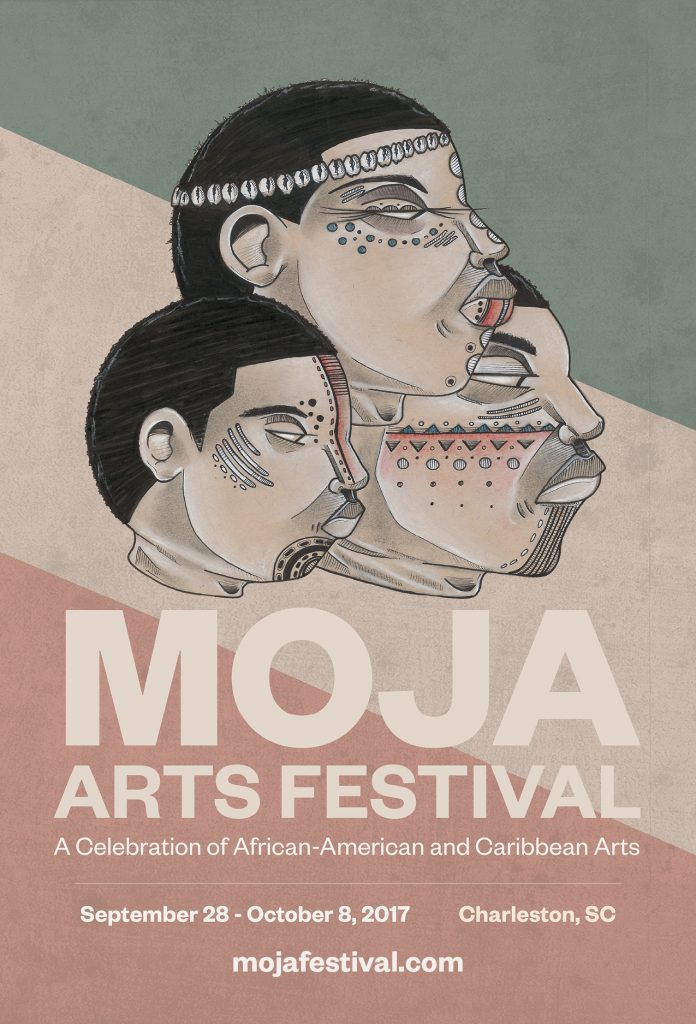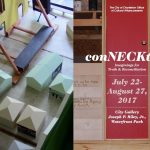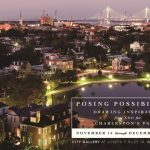MOJA Visual Arts

The City of Charleston Office of Cultural Affairs presents visual arts exhibitions by multiple artists at City Gallery September 28 through October 29, 2017. Included are: Libation, an installation by artists Roni Nicole Henderson (film, photography), Dogon Krigga (graphic design), and Cedric Umoja (multi-media, muralist); Dance of the Ancestors: Egungun Masquerade, featuring work by Orisanmi Kehinde Odesanya; and the MOJA Arts Festival Juried Art Exhibition, juried by Ms. Odesanya. An awards ceremony for the Juried Art Exhibition will be held Saturday, September 30 from 5 to 7 p.m. This event is free and open to the public. A schedule of related events and performances will be available on the MOJA Festival and City Gallery website.
MOJA Juried Art Exhibition
September 28-October 9
This annual juried art exhibition features work from artists living in the Southeast in a range of styles and media. In it, viewers will find artworks in photography, painting, drawing, graphic arts, fiber arts, sculpture, ceramics, basketry, and more.
This year’s juror is Orisanmi Kehinde Odesanya, whose work was exhibited at the City Gallery as part of the 2016 exhibition Sixteen Crowns: Manifestations of Ase and is central to this year’s Dance of the Ancestors: Egungun Masquerade. Based in Cleveland, Ohio, Odesanya is an artist, storyteller, and author. With a background in costuming and academic studies in African Art and religious art forms, she has developed an art practice that includes writing and following the rich cultural tradition of the African Masquerade through doll making and metaphysical interpretation. Her published works include Kwanzaa: A Learning Guide for Parents, Teachers, and Children.
Artists included in this year’s exhibit were Kelvin Blufton, Deane Bowers, KTC, Andrea Monilola Curtis-Foster, Suzanne Day, Lynda English, Marcel Foster, Susanne Frenzel, Sufia Giza, Art Gomez, Wonda F. Hillard, Chuck Hooker, Jenny LeVine, Verneda Lights, Aisha Lumumba, Kris Manning, Jeanne Mays, Zaire McPhearson, Melanee Molette, Michael Morrison, Aldo Muzzarelli, Daina Nathaniel, Habibur Rahman, David Sanders, Maria Spinosa, Harriette Vanderhorst, Scott Washington, and Torreah “Cookie” Washington.
Awards were given to Wonda F. Hillard for Best Gullah/Cultural for her work Mother and Child, to Verneda Lights for Best Religious/Spiritual for Gullah Me: The Tree Is Me, and to Kris Manning for Best Cultural Commentary for Compassion.
Libation
September 28-October 29
In the tradition of the Ancestors of Black people in America and abroad, the giving of libation has been a practice which is deeply rooted in black culture. It’s not just the action of pouring out a drink for those who are no longer on earth with us, but much more than that: it’s the recollection, remembrance, and celebration of the life and lifetimes of those who have passed on to other side as an Ancestor.
This exhibition consists of mixed media works, a short film installation, as well as a wall-to-floor installation. The artists offer healing to the community on a local and state-wide level, as they examine a lack of acknowledgement for the diverse experiences through many people’s lives in the black community. Artists include Roni Nicole Henderson (film, photography); Dogon Krigga (graphic design); and Cedric Umoja (multi-media, muralist).
Dance of the Ancestors: Egungun Masquerade
September 28-October 29
The footprints of ancestors are continually evident and in many cultures, their perceived presence provides wisdom, comfort, guidance, and curatives for the living. Worldwide, African peoples continue to honor, celebrate, and venerate their ancestors. For the Yoruba people of West Africa, ancestor veneration often takes the form of a masquerade.
The masquerade, sometimes called a “spectacle” commands the attention of all. When the masquerade appears, a portal between the seen and unseen opens, allowing the spirits of the ancestors to descend to the earthly realm. During the masquerade dance, blessings, iwure, are dispensed to individuals and the community as a whole. Blessings are distributed to ensure physical protection and safety, good health, longevity, a plentiful harvest, and economic and familial prosperity.
The masquerade tradition features a mask comprised of colorful panels of fabric, which is also accompanied by fly whisks, fans, and bells. As the dancer performs the masquerade, the colorful panels are seen swirling around the dancer; each movement is believed to remove negative forces and placate the Great Mothers, ancestors who have the ability to bestow blessings and conversely, to curse. Through close observation of the masquerade, one can discover proverbial wisdom, commentary on social customs, as well as socio-political satire.
Performed at yearly festivals, weddings, birth and funeral rites, the masquerade serves to unite the ancestors with the living, connecting past to present while ensuring blessings for the future.
Dance of the Ancestors: Egungun Masquerade features sculptures of various sizes, called ere,
or spirit vessels. Focusing primarily on Yoruba masquerade, the many styles reflect the diversity and creativity of the culture through the artistic eye of Orisanmi Kehinde Odesanya. Odesanya began creating these ancestral vessels in 2015, seeking to educate the public on African masking traditions. A Gelede Mask costume figures prominently in the display, accompanied by a photo documentary representing the mask in process.
Dance of the Ancestors will include a performance event in which the mask will be danced, bringing its energy to life and blessing all those who witness its magic.
The opening reception at the City Gallery to be held on September 30 will feature a masking ceremony of a second Gelede Masquerade honoring the social custom of offering head wraps, gele, or baby sashes, oro, for the masquerade. Each head wrap is considered a sacrificial offering, etutu, representative of the many individuals who comprise a community.
The Dance of the Ancestors: Egungun Masquerade includes the work of artist Orisanmi Kehinde Odesanya, (Joyce Morrow Jones), Cleveland, OH, and is curated by Dr. Dr. Ade Ofunniyin , Adjunct Professor College of Charleston and Executive Director of the Gullah Society and Project Director of the Gullah Society Sacred Burial Ground Projects. Curatorial support was provided by Jody Berman, PhD Candidate and Robin Poynor, PhD.
Servant Leadership
October 19 – October 29
Servant Leadership highlights some of the more than 65 posters that Green has created over his career for nonprofits and community organizations. The collection of posters in Servant Leadership is a reflective summary of artist Jonathan Green’s untold story of noteworthy and significant work that has resulted in uncounted cumulative funding for organizations throughout the nation. It illuminates, for the first time, the impact and influence that Jonathan Green’s work has had on our society from a community service perspective. The images in Servant Leadership are representative of years of work and service by Jonathan Green.
While he has enjoyed commercial success due to the wide acceptance and collection of his art, Jonathan Green has never forgotten from whence he came or his instilled system of values. His generosity in the use of his images by community organizations for fundraising and public relations endeavors geared toward the uplifting and edification of their respective philanthropies exemplifies his spirit of giving. His work has been used as inspiration and support for education, the arts, healthcare and reading programs among others. Green’s art is represented in some of the finest museums and collections in the world, and yet he continues to share his images with the masses by way of book covers, calendars and posters whose proceeds fund missions of communities in need.
About the Artists
Cedric Umoja was born in San Francisco, California, but is based out of Columbia, South Carolina. He has been influenced by the likes of Dondi White, Sam Kieth, Max Beckmann, Amedeo Modigliani, Rammellezee, Ernie Barnes, Sun Ra and Hans Hoffman. The elements of Graffuturism, Neo- Expressionism, Afro- Surrealism, Comic sequencial art, Japanese manga and Afrofuturism have played a role in his artistic development and can also be found in his work. Cedric Umoja developed his style under the instruction of Tony Cacalano, a Yale MFA and veteran Fine artist, whose own teachers included Jack Tworkov, one of the founders of the now Famed New York school.
Orisanmi Kehinde Odesanya has been designing and creating dolls for over 20 years. Through a passion for African art and culture, she has created more than 200 small-scale figures to honor Yoruba deities and masqueraders. Along with her small-scale figures, Orisanmi has created a full-sized Gelede mask and costume for Dance of the Ancestors: Egungun Masquerade. Her work embodies the wisdom and folklore of oral tradition and thereby represents the philosophy, spirituality and performance of Yoruba expressive culture.
Jonathan Green is a nationally acclaimed and awarded professional artist who graduated from The School of the Art Institute of Chicago. His thirty-eight year track record of creating art and extensive listing of his inclusions in museum collections and exhibitions throughout many countries has led to his being considered by numerous art critics as one of our nation’s outstanding American visual master artists recognized for capturing the positive aspects of American and African American Southern culture, history, and traditions. Mr. Green’s art and talents have been incorporated into productions of ballet, music, opera, theatre, literature, film, and video documentaries throughout the United States. Additionally, his art has been included in numerous educational publications addressing American and African American history. Currently Jonathan Green resides and paints in his studio located in downtown Charleston, South Carolina.


